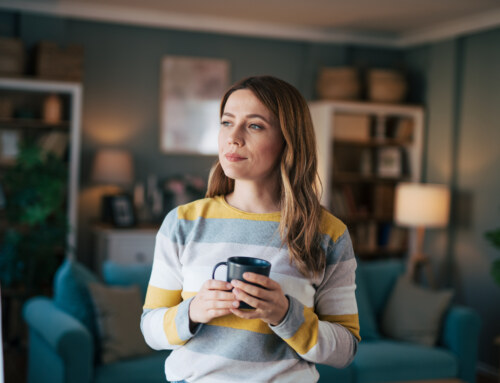Let’s talk about anxiety—not the fleeting kind you get before a big presentation, but the kind that camps out in your body, overstays its welcome, and keeps you up at 2 a.m. replaying conversations from 3 days ago.
Anxiety is a natural part of being a human. After all, it helps us stay alert in the face of danger and gives us that burst of adrenaline when we need it. Unfortunately, for many people, anxiety does not know when to hit the brakes. It goes beyond the occasional worry and becomes a daily struggle that affects their thoughts, emotions, and ability to function.
And here’s the thing: anxiety is not one single experience. Some people may be more likely to experience anxiety, such as those who are neurodiverse, have experienced trauma, or are part of the LGBTQ+ or BIPOC communities.
It’s important to remember that there’s no “right” way for anxiety to show up, and everyone experiences it differently. For one person, anxiety might feel like an ongoing worry about everything. For another, it might show up as avoidance, scanning every room for exits, or having difficulty making eye contact. No matter how it looks, there’s no shame in the way anxiety takes shape in your life.
In recognition of this year’s Mental Health Week, let’s explore five of the most common types of anxiety disorders, peek behind the symptoms, and gently name the supports that can help.
Generalized Anxiety Disorder (GAD)
Ever had your brain latch onto something—anything—and then spiral with “what ifs”? What if I forgot to send that email? What if I get sick? What if they’re mad at me?
Well, that is what is known as Generalized Anxiety Disorder. It’s like your mind is stuck in a loop of invisible alarms, even when everything seems “fine” on the outside. For those living with GAD, this kind of anxiety doesn’t simply come and go; it can last for months or even years, often making it difficult to manage daily responsibilities or maintain a sense of calm.
People with GAD often:
- Feel restless or on edge
- Struggle to sleep or stay asleep
- Experience fatigue, tension, or brain fog
- Have a hard time not worrying—about work, health, family, or just… life
The exact cause of GAD isn’t fully understood, but it likely stems from a combination of factors: genetics, past trauma, chronic stress, or a nervous system that’s learned to be on high alert. Mindfulness practices, gentle lifestyle shifts, and therapy approaches like Acceptance and Commitment Therapy (ACT) can all help.
Imagine a life where your thoughts still visit, but they don’t run the show. That’s possible.
Social Anxiety Disorder
Social anxiety isn’t just being “introverted” or “a little shy.” It’s the dread before a birthday party, the sweaty palms before speaking up in class, and the replay reel that starts the moment you leave the room. It’s an intense fear of being judged, embarrassed, or rejected in social or performance situations.
People with social anxiety often worry for days or weeks before an event and may replay their interactions in their head afterward, overly focusing on what they think they did wrong. This kind of anxiety often starts young and can be shaped by past experiences of criticism, bullying, or a sensitive nervous system wired for caution. Those with this disorder might:
- Avoid eye contact
- Skip events, meetings, or conversations
- Worry for days before and after social situations
But here’s the hopeful part: confidence is a skill that can be rebuilt. With the right support, you can unlearn the fear of being seen, and slowly let yourself take up space again.
Panic Disorder
Panic attacks are like emotional earthquakes. They show up uninvited, shake your body and mind, and leave you wondering if something is really wrong.
If you’ve ever felt your heart race, breath shorten, chest tighten, and thoughts spiral all at once—you’re not alone. Panic attacks are more common than people think, and they’re not “in your head.” They’re real, physiological responses that feel like danger, even when you’re safe. These attacks can feel terrifying and may happen without any warning.
The challenge? The fear of having another panic attack can become so overwhelming that people begin avoiding places or situations where they fear one might occur.
But like any storm, panic passes. And with the right mix of therapeutic tools, nervous system education, and support, people can learn to ride the wave instead of fear the next one. Freedom is possible.
Obsessive-Compulsive Disorder (OCD)
Let’s clear this up: OCD isn’t about being neat or liking your bookshelf organized by colour. It’s a real and often misunderstood anxiety disorder marked by obsessions—intrusive, persistent thoughts—and compulsions, which are repetitive behaviours or mental rituals done to try to ease the anxiety those thoughts create.
Intrusive thoughts can be intense and unsettling. They often fixate on fears of harm, contamination, or making a serious mistake. These thoughts aren’t reflective of someone’s values or intentions, but they can feel so alarming that the brain scrambles to find relief. That’s where compulsions come in—temporary attempts to quiet the distress.
Someone with OCD might:
- Wash their hands repeatedly
- Check locks over and over
- Mentally repeat words or phrases
- Avoid certain places or actions for fear of causing harm
These behaviours aren’t about preference or control. They’re ways of trying to feel safe. Many people with OCD know their thoughts and behaviours don’t fully make sense, but the anxiety is overpowering—and the urge to make it stop is real.
OCD can feel overwhelming, but it is treatable. Therapies like Exposure and Response Prevention (ERP) or Acceptance and Commitment Therapy (ACT) can help people relate to their thoughts differently—without getting pulled into the cycle. It’s tough work. But that strength? You’ve already got it.
Specific Phobias
We all have fears. But a specific phobia is when that fear becomes so intense it starts to shape your life. Whether it’s spiders, flying, needles, or elevators, phobias can lead people to go out of their way to avoid triggers.
Sometimes, people don’t even know exactly how or when the fear began. They might recognize that it’s irrational, but that doesn’t make the body’s response any less real.
Specific phobias can develop in childhood or stem from a traumatic event. Other times, they appear without a clear cause—and that’s okay. You don’t need to know why in order to deserve support.
With therapy, exposure work, and mindfulness-based strategies, many people gradually move from fear to freedom, one brave step at a time.
Facing Anxiety With Support at Healing Spaces
Anxiety can feel like walking a tightrope with no net, but you don’t have to do it alone.
Whether your anxiety whispers, yells, or hums quietly in the background, your experience is valid, and there is a way forward.
At Healing Spaces, we offer counselling for all types of anxiety, both in-person and virtual. We meet you with compassion, without judgment, and with deep respect for the stories your nervous system holds.
To support you between sessions, we’ve created a free downloadable resource available on our website. We also offer direct billing to help make things a little easier.
Remember, you are not broken. You are becoming. And it would be our honour to walk alongside you. Book your free consultation today.





